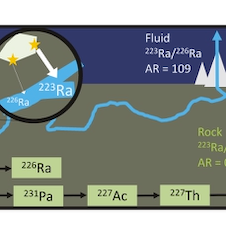Link to online paper: https://onlinelibrary.wiley.com/doi/abs/10.1029/2021JC017886
Abstract
The residence time of fluids circulating through deep-sea hydrothermal systems influences the extent of water-rock reactions and the flux of major and minor elements to the ocean. While the fluid residence times in numerous basaltic and gabbroic systems have been determined, those of the less studied ultramafic systems are currently unknown. Fluids that interact with mantle rocks have fundamentally different chemistries and therefore have unique influences on seawater chemistry. In this first investigation of radium isotopes in a serpentinite-hosted system, vent fluids were discovered to contain 10–100 times greater activities of 223Ra (half-life = 11.4 days) than observed in high-temperature basalt-hosted systems. The 223Ra activities of 10–109 dpm L−1 produce 223Ra/226Ra activity ratios ranging from 9 to 109. These extremely high 223Ra activities, which are accompanied by low activities of 226Ra, place significant constraints on fluid residence times and the adsorption coefficient of radium between fluid and rock. Our data constrain the nondimensional retardation factor (R) to very low values between 1 and 4, reflecting the extent to which Ra is transported more slowly than fluids due to adsorption and other processes. These results suggest that the residence time of fluids in contact with serpentinite is less than 2 y and perhaps as low as 0.5 y. They are surprisingly similar to those of basalt-hosted systems. Thus, fluids in hydrothermal systems share similar hydrogeological characteristics despite differences in rock types, underlying porosity, and heat sources, enabling larger-scale models of hydrothermal biogeochemistry to be developed across systems.
